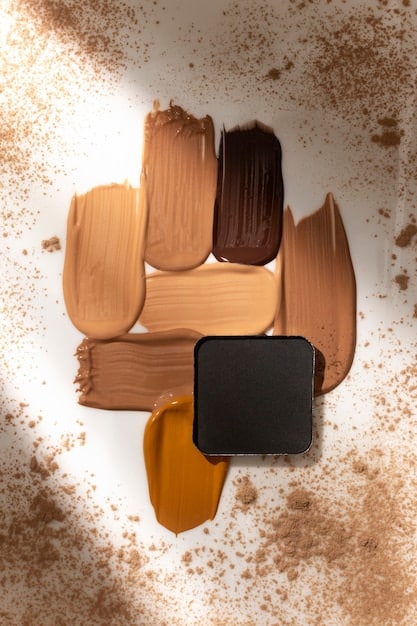How to Choose the Right Foundation for Your Skin Type in 2025: A Comprehensive Guide

Anúncios
Choosing the correct foundation is pivotal for a flawless makeup look, and this guide provides an in-depth understanding of how to select the ideal product tailored to individual skin types, considering the latest innovations and trends for 2025.
Navigating the vast world of beauty products can be daunting, especially when it comes to finding the perfect foundation. This comprehensive guide, How to Choose the Right Foundation for Your Skin Type in 2025: A Comprehensive Guide, delves into the essential considerations and innovative solutions appearing in the market, ensuring your complexion always looks its best.
Understanding Your Skin Type: The First Step to Flawless Foundation
Before even considering shades or finishes, the cornerstone of choosing the right foundation lies in profoundly understanding your unique skin type. This fundamental insight dictates the formulation, ingredients, and texture that will best complement your complexion, ensuring longevity and a healthy appearance.
Mismatched foundation can exacerbate skin concerns, leading to an uneven finish, clogged pores, or an undesirable texture. Identifying whether your skin is oily, dry, combination, sensitive, or mature is the critical first step in this highly personalized beauty journey.
The Oily Skin Dilemma: Mattifying Formulas and Oil Control
For those with oily skin, the challenge often revolves around combating shine, excess sebum production, and ensuring foundation doesn’t slide off by midday. The market in 2025 offers advanced formulations specifically designed to address these concerns.
- Oil-Free and Non-Comedogenic Formulas: Essential to prevent pore clogging and breakouts. Look for labels that explicitly state these attributes.
- Matte or Semi-Matte Finishes: These help to control shine throughout the day, providing a more balanced appearance.
- Long-Wearing Properties: Foundations with extended wear capability are crucial for oily skin, resisting breakdown due to oil and sweat.
- Powder-Based or Liquid-to-Powder Formulations: These can offer excellent oil absorption and a smooth finish.
Beyond traditional liquid and powder foundations, newer hybrid formulas are emerging that combine the best of both worlds, offering controlled shine without feeling overly dry or cakey. The emphasis in 2025 is on balance and breathability, allowing the skin to look natural while keeping oil at bay.
Nourishing Dry Skin: Hydration and Dewy Finishes
Dry skin requires a foundation that provides ample hydration and avoids accentuating flaky patches or fine lines. The right foundation for dry skin will leave it feeling comfortable and looking luminous, not tight or dull.
Hydrating and luminous foundations are key for dry skin, as they prevent the product from settling into fine lines and provide a healthy glow. Many brands are now infusing foundations with skincare benefits, making them an extension of your daily hydration routine.
Ultimately, a deep understanding of your skin’s needs is the compass that guides you through the foundation aisle. Neglecting this crucial first step can lead to frustration and wasted product, reinforcing the importance of tailoring your choice to your specific skin type.
Navigating the Foundation Landscape: Finishes, Coverage, and Formulas
Once your skin type is identified, the next step involves exploring the myriad of finishes, coverage levels, and formulas available. This is where personal preference meets product innovation, allowing you to fine-tune your selection for the desired aesthetic and functionality.
The beauty industry in 2025 is characterized by an unprecedented diversification of foundation types, moving beyond the traditional liquid and powder to include cutting-edge formulations like serums, sticks, and cushions, each offering unique benefits.

The Spectrum of Finishes: From Matte to Luminous
The finish of a foundation refers to how it looks on the skin once it sets. This impacts the overall appearance of your complexion and should align with your skin type and desired aesthetic.
- Matte Finish: Ideal for oily or combination skin, providing a shine-free, velvety look.
- Satin/Natural Finish: Offers a balance between matte and luminous, mimicking healthy skin. Suitable for most skin types.
- Dewy/Luminous Finish: Best for dry or mature skin, imparting a glowy, hydrated appearance.
- Semi-Matte Finish: A flexible option, providing some oil control while retaining a natural skin-like look.
Choosing the right finish is not merely a cosmetic decision; it’s about optimizing skin comfort and product longevity. A dewy foundation on oily skin may feel heavy and break down quickly, while a matte one on dry skin can feel tight and emphasize dryness.
Coverage Levels: Sheer, Medium, and Full
Foundation coverage dictates how much of your skin’s natural tone and imperfections will be masked. This choice depends on your personal preference and what you wish to conceal or enhance.
Sheer coverage aims to even out skin tone without hiding freckles or natural imperfections, offering a “my skin but better” look. Medium coverage builds up to conceal minor redness or blemishes while still looking natural. Full coverage provides maximum concealment,
ideal for significant discoloration, acne, or for a more dramatic, event-ready appearance.
Many modern foundations are buildable, meaning a sheer layer can be applied for light coverage, and more product can be added in specific areas to achieve medium or full coverage as needed. This flexibility is a significant advantage for versatile looks.
Understanding Foundation Formulas: Liquids, Creams, Powders, and More
The composition of a foundation significantly influences its application, wear, and suitability for different skin types.
1. Liquid Foundations: The most common type, available in a vast array of finishes and coverage levels. They are versatile and can suit most skin types, depending on their specific formulation (oil-free for oily skin, hydrating for dry skin).
2. Cream Foundations: Often thicker and more emollient, providing medium to full coverage and excellent for dry or mature skin due to their hydrating properties. They can also be found in stick form for easy application.
3. Powder Foundations: Best for oily skin, offering a matte finish and good oil absorption. They can provide sheer to medium coverage and are convenient for touch-ups. Mineral powder foundations are also popular for sensitive skin.
4. Serum Foundations: A relatively new innovation, these combine the lightweight texture of a serum with tint, providing sheer to light coverage with added skincare benefits like hydration or antioxidants. Ideal for those who prefer a minimalist approach.
5. Cushion Foundations: Originating from Korea, these consist of a liquid foundation soaked in a sponge cushion. They offer a dewy finish and light to medium buildable coverage, perfect for on-the-go application and touch-ups.
In 2025, the trend leans towards hybrid formulas that blur the lines between skincare and makeup, offering treatments alongside coverage. Whether it’s a foundation infused with SPF, hyaluronic acid, or prebiotics, these multi-tasking products address both cosmetic and skincare needs, simplifying routines and enhancing overall skin health.
Choosing the correct formula, coverage, and finish is a nuanced process. It requires understanding your daily needs, desired aesthetic, and how different formulations interact with your specific skin type and environmental conditions. Experimentation, though sometimes costly, is often the best teacher in this journey.
The Art of Shade Matching: Finding Your Perfect Hue
Once you’ve pinpointed your skin type and preferred formula, the next hurdle is arguably the most crucial for a seamless look: shade matching. A perfectly matched foundation should virtually disappear into your skin, creating a unified canvas rather than a visible layer.
The complexity lies not just in finding the right depth of color, but also in identifying your skin’s undertone. A foundation that is too warm, too cool, or too neutral will look unnatural, even if the depth is correct. This step transforms foundation from a mask into a second skin.
Understanding Undertones: Cool, Warm, and Neutral
Your skin’s undertone is the subtle hue beneath the surface, independent of how light or dark your skin appears. It plays a significant role in how makeup shades translate on your complexion.
- Cool Undertones: Skin may have pink, red, or bluish tints. Veins on your wrist often appear blue or purple. Silver jewelry tends to flatter your skin.
- Warm Undertones: Skin may have yellow, golden, or peachy tints. Veins on your wrist often appear green. Gold jewelry tends to flatter your skin.
- Neutral Undertones: Skin has a balance of pink and yellow tones. Veins may appear a mix of blue and green, or it’s hard to tell. Both gold and silver jewelry look good on you.
Knowing your undertone is paramount. Many foundation lines now categorize their shades not just by number or name, but also by their undertone (e.g., C for Cool, W for Warm, N for Neutral). This simplifies selection significantly.
Testing in the Right Places and Lighting
The traditional method of swatching foundation on your hand or arm is generally misleading as these areas often have a different shade or undertone than your face and neck.
The most accurate places to test foundation are along your jawline or a small patch on your neck, blending it slightly towards your ear. This allows you to see how the shade seamlessly transitions from your face to your neck.
Always test foundation in natural light. Store lighting, whether fluorescent or warm incandescent, can distort colors and lead to an inaccurate match. If possible, step outside the store or near a window to observe the foundation’s true color on your skin.
Allow the foundation to set for a few minutes before making a final decision. Some formulas can oxidize, meaning they darken slightly after exposure to air and your skin’s oils. What looks perfect initially might become too dark after a short period.
Ultimately, shade matching requires patience and keen observation. Don’t rush the process, and if in doubt, ask for samples to test over a full day at home before committing to a full-sized product. The goal is an invisible fit, where your foundation enhances, not conceals, your natural beauty.
Application Techniques for a Seamless Finish in 2025
Even with the perfect foundation for your skin type and shade, the application method can make or break your final look. With advancements in foundation formulas and tools, refining your technique is key to achieving a flawless, natural-looking finish in 2025.
The aim is to apply foundation in a way that truly melts into your skin, rather than sitting on top of it. This requires understanding the nuances of different tools and tailoring your approach to the foundation’s consistency.
Tool Talk: Brushes, Sponges, and Fingers
Each application tool offers a distinct result and is better suited for certain foundation types and desired finishes.
- Foundation Brushes:
- Flat-top Kabuki or Buffing Brushes: Excellent for liquid and cream foundations. They provide an even, airbrushed finish and can build up coverage. Use circular buffing motions.
- Flat Brushes: Good for more precise application and can offer higher coverage. Use sweeping or patting motions.
- Makeup Sponges (e.g., Beauty Blender):
- Best used damp, they provide a sheer to medium, natural finish. Sponges absorb excess product, preventing a cakey look, and are ideal for blending and pressing foundation into the skin for a seamless effect. Use a stippling or bouncing motion.
- Fingers:
- Good for sheer to medium coverage foundations, especially tinted moisturizers or light liquids. The warmth of your fingers helps melt the product into the skin, providing a natural, skin-like finish. Ensure hands are clean to avoid transferring oils or bacteria.
While brushes offer precision and sponges provide a natural blend, many find that a combination of tools works best. For instance, applying foundation with a brush for initial coverage, then blending with a damp sponge for a refined, seamless finish.
Prepping Your Skin: The Foundation’s Best Friend
No matter the foundation or application method, proper skin preparation is non-negotiable for a smooth, lasting finish. This routine creates an optimal canvas for your makeup.
Start with a clean, moisturized face. Hydrated skin allows foundation to glide on smoothly and prevents it from clinging to dry patches. After moisturizing, apply a primer. Primers create a barrier between your skin and makeup, helping foundation last longer, fill in pores, or control oil, depending on the primer’s formulation.
Allow each skincare product (moisturizer, SPF, primer) to fully absorb before layering the next. This prevents products from pilling or disrupting your foundation application. Rushing this step can lead to a patchy or uneven base.
When applying foundation, start with a small amount and build coverage as needed. It’s easier to add more product than to remove excess without disturbing other makeup. Focus on areas that need more coverage (e.g., around the nose, under eyes, or blemishes) and blend outwards towards the edges of your face and jawline to avoid harsh lines.
Dotting the foundation over the face before blending can help distribute product evenly. For a truly invisible blend, extend foundation slightly onto the neck and ears, especially if wearing your hair up. This ensures a cohesive look from all angles.
Finally, consider setting your foundation with a translucent powder or setting spray, especially if you have oily skin or want extended wear. This step locks in your foundation, preventing transfer and adding to its longevity. The right application technique transforms a good foundation into a great one, ensuring your complexion looks perfected, not masked.
Foundations for Specific Concerns: Sensitive Skin, Acne-Prone, and Mature Skin
Beyond the basic skin types, many individuals have specific concerns that require a more nuanced approach to foundation selection. The beauty industry in 2025 is increasingly catering to these needs with specialized formulations designed to address issues like sensitivity, acne, and signs of aging.
Choosing a foundation that either avoids exacerbating existing conditions or actively delivers beneficial ingredients can significantly improve both the look and health of your skin. This segment focuses on foundations that go beyond mere coverage.
Sensitive Skin: Gentle Formulas and Hypoallergenic Options
Sensitive skin reacts easily to various ingredients, often manifesting as redness, itching, or breakouts. For this skin type, ingredient lists are as important as the finish or coverage.
- Minimalist Formulas: Look for foundations with fewer ingredients to reduce the chance of irritation.
- Fragrance-Free and Alcohol-Free: These are common irritants that sensitive skin often reacts negatively to.
- Non-Comedogenic and Dermatologist-Tested: Indicators that the product is less likely to clog pores or cause allergic reactions.
- Mineral-Based Foundations: Often well-tolerated by sensitive skin due to their natural composition and lack of synthetic dyes or preservatives.
Patch testing new foundations on a small, discreet area (like behind the ear or on the neck) for a few days before full application is a wise practice for sensitive skin. This proactive step helps identify potential irritants without causing widespread reaction.
Acne-Prone Skin: Non-Occlusive and Skin-Treating Foundations
Acne-prone skin requires foundations that won’t clog pores or aggravate breakouts, and ideally, those that contain ingredients to actively help clear or prevent blemishes.
Opt for “non-comedogenic” and “oil-free” formulas. These are specially designed to not block pores. Matte or semi-matte finishes are typical recommendations as they help control excess oil, a common trigger for breakouts. Some foundations for acne-prone skin now include ingredients like salicylic acid or tea tree oil, which have blemish-fighting properties. However, caution is advised as these can sometimes be drying, requiring a balanced skincare routine.
Avoid heavy, occlusive formulas that can trap bacteria and sebum, leading to further breakouts. Lightweight liquid or powder foundations are often preferred. The trend for 2025 also includes foundations with anti-inflammatory ingredients, aiming to reduce redness and soothe irritated skin while providing coverage.
Mature Skin: Hydrating, Luminous, and Non-Creasing Formulas
Mature skin often faces challenges like dryness, fine lines, wrinkles, and loss of elasticity. The right foundation can minimize the appearance of these concerns, providing a more youthful and radiant look.
Creamy, hydrating liquid or serum foundations with a dewy or luminous finish are generally recommended. These formulas help plump up the skin, providing a healthy glow and diverting attention from fine lines, unlike matte foundations which can accentuate them.
Foundations infused with anti-aging skincare ingredients such as peptides, hyaluronic acid, collagen, or antioxidants are increasingly popular. These provide not just cosmetic coverage but also contribute to skin health over time. Avoid thick, heavy formulas that can settle into wrinkles and make them more prominent. Lightweight, buildable coverage is often preferred, allowing the skin’s natural texture to show through subtly.
Applying foundation with a damp sponge or fingers can help press the product into the skin for a smoother, less detectable finish, preventing it from caking on dry areas. The focus for mature skin is on luminosity, hydration, and a formula that moves with the skin, rather than sitting rigidly on top of it.
Selecting a foundation based on specific skin concerns moves beyond simple aesthetics to a holistic approach to skin health. By prioritizing ingredients and formulations aligned with your skin’s unique needs, you can achieve a flawless complexion that feels as good as it looks.
Future of Foundation: Innovations and Trends in 2025
The beauty industry is in a constant state of evolution, and foundation technology is no exception. As we look towards 2025, several key innovations and trends are shaping the future of this essential makeup product, promising even more personalized, effective, and sustainable options for consumers.
These advancements are driven by a combination of consumer demand for bespoke solutions, a growing emphasis on skin health, and a push for environmental responsibility. Understanding these trends can help you make informed choices that align with cutting-edge beauty practices.
Hyper-Personalization: Custom-Blended Formulas
One of the most exciting trends is the rise of hyper-personalization in foundation. Brands are increasingly offering services where foundations are custom-blended on demand, taking into account individual skin tone, undertone, type, and even specific concerns like redness or hyperpigmentation.
This technology uses advanced skin analysis (often AI-powered) to create a truly unique shade and formula that perfectly matches the wearer’s complexion, eliminating the frustration of finding the “perfect” pre-made shade. These bespoke foundations often come with customized skincare ingredients mixed in, blurring the lines between makeup and treatment.
Skincare-Infused Foundations: The “Skinification” of Makeup
The trend of “skinification” continues to dominate, with foundations increasingly acting as extensions of skincare routines. In 2025, expect to see more foundations packed with potent active ingredients previously reserved for serums and moisturizers.
- Hyaluronic Acid: For intense hydration, maintaining skin plumpness throughout the day.
- Niacinamide: To improve skin barrier function, reduce redness, and minimize pores.
- Antioxidants (e.g., Vitamin C, Vitamin E): To protect against environmental damage and brighten the complexion.
- Prebiotics and Probiotics: To support the skin’s microbiome and enhance overall skin health.
These multi-tasking formulas not only provide coverage but also work to improve skin quality over time, offering preventative benefits and treatments alongside cosmetic enhancement.
Sustainable and Ethical Foundations
Consumer demand for more responsible beauty products is driving significant change in foundation development. In 2025, expect to see a stronger emphasis on:
- Clean Formulas: Foundations free from parabens, phthalates, sulfates, and other potentially harmful chemicals.
- Eco-Friendly Packaging: Refillable options, recyclable materials, and packaging made from post-consumer recycled plastic.
- Ethical Sourcing: Ingredients harvested responsibly with fair labor practices.
- Cruelty-Free and Vegan Options: A continued rise in foundations that are not tested on animals and do not contain animal-derived ingredients.
Transparency in ingredient sourcing and manufacturing processes is becoming a key selling point, allowing consumers to make choices that align with their values.
Advanced Textures and Finishes
Expect innovations in foundation textures, with an even greater focus on lightweight, breathable formulas that offer buildable coverage without feeling heavy. Micro-fine powders, encapsulation technologies, and biopolymer networks are creating foundations that adapt to skin texture and movement, providing a more natural and comfortable wear.
New finishes may emerge that offer hybrid effects, such as “soft-focus matte” for a shine-free but not flat look, or “glass skin glow” for an ultra-luminous, almost wet-look finish. These innovations aim to cater to diverse aesthetic preferences while maintaining skin health.
The future of foundation in 2025 is bright, promising a landscape of products that are smarter, more tailored, and more aligned with both individual skin needs and global sustainability goals. Staying abreast of these trends can help you discover products that not only perfect your complexion but also contribute to healthy skin and a healthy planet.
Common Foundation Mistakes to Avoid
Even with the right knowledge, it’s easy to fall into common foundation pitfalls that can undermine your desired look. Avoiding these errors is as crucial as making the right choices in your selection process, ensuring your foundation enhances rather than detracts from your natural beauty.
From incorrect shade matching to improper application, these seemingly minor mistakes can significantly impact the overall finish and longevity of your makeup. Being aware of them allows for a more refined and professional result.
1. Ignoring Skin Preparation: Not cleansing, moisturizing, and priming your skin before applying foundation is a common mistake. Dry patches will be accentuated, and foundation won’t glide on smoothly, leading to a patchy, uneven finish that looks “cakey” and doesn’t last. Proper skin prep creates a smooth canvas for seamless application and prolonged wear.
2. Testing Shade on the Wrong Body Part: Swatching foundation on your hand or arm is inaccurate as these areas rarely match the skin tone of your face and neck. This often leads to buying a shade that doesn’t blend seamlessly. Always test foundation on your jawline and blend it down to your neck in natural light to ensure a perfect match.
3. Over-Applying Product: Applying too much foundation at once is a surefire way to achieve a heavy, mask-like appearance. It can also lead to product settling into fine lines and wrinkles. Start with a small amount in the center of your face and blend outwards, building coverage only where needed. Less is often more for a natural finish.
4. Using the Wrong Undertone: Even if the depth of the foundation is correct, an incorrect undertone (cool, warm, or neutral) can make your foundation look off – either too yellow, too pink, or even grey. Understanding your skin’s undertone is vital for a truly harmonious match that blends invisibly with your neck and décolletage.
5. Not Setting Your Foundation (Especially for Oily Skin): Skipping a setting powder or spray can lead to your foundation sliding off, creasing, or becoming oily by midday, particularly if you have oily or combination skin. A light dusting of translucent powder in the T-zone or an all-over setting spray can significantly extend wear and control shine.
6. Applying Foundation to Dry or Flaky Skin: Foundation clings to dry patches and dead skin cells, making them more noticeable. Regularly exfoliating and moisturizing dry skin is essential before foundation application. For significant dryness, opt for hydrating and luminous foundation formulas that won’t exacerbate flakiness.
By consciously avoiding these common errors, you can transform your foundation routine from a potential pitfall into a powerful tool for achieving a truly flawless and natural-looking complexion. Attention to detail in both selection and application yields the best results.
Maximizing Foundation Performance: Tips & Tricks for All Skin Types
Beyond choosing the right foundation and avoiding common mistakes, there are several universal tips and tricks that can significantly enhance the performance of any foundation, ensuring a flawless and long-lasting finish regardless of your skin type or the product you’re using. These are the nuances that elevate a good foundation application to a great one.
From layering techniques to strategic touch-ups, these insights provide practical advice for achieving a perfected complexion that stands the test of time and various conditions.
Layering and Strategic Application
While the goal is often to use less foundation for a more natural look, strategic layering can address specific concerns without creating a heavy finish.
- Targeted Coverage: Instead of applying a thick layer everywhere, focus the most coverage on areas that truly need it (e.g., redness, blemishes, hyperpigmentation). Use a lighter hand or sheerer product on areas with good skin tone.
- Sheer to Build: Start with a sheer layer of foundation across your face. If more coverage is needed in certain spots, go back with a small amount and pat or stipple it over those specific areas. This builds intensity without adding unnecessary bulk.
- Concealer First or Last? While most apply foundation first, some makeup artists recommend applying a thin layer of color-correcting concealer before foundation for targeted issues like dark circles or severe redness. Others prefer applying concealer after foundation to cover any remaining imperfections precisely. Experiment to see what works best for your needs.
The “less is more” approach, combined with strategic layering, gives the skin a perfected look that still resembles natural skin, allowing its texture to show through beautifully.
Prep and Prime for Longevity
A well-prepped canvas is the secret to foundation longevity. This goes beyond washing and moisturizing to include targeted priming.
Use a primer that addresses your primary skin concern: a mattifying primer for oily areas, a hydrating primer for dry patches, or a blurring primer for prominent pores. Apply primer sparsely, only where needed, to avoid feeling heavy or pilling. Allow the primer to set for a minute or two before applying foundation, letting it create an effective barrier.
Consider using an eye primer on your eyelids even if only applying foundation, as this can prevent creasing and help any eyeshadow or liner you apply later last longer.
Setting and Refreshing During the Day
Setting your foundation is crucial, especially for oily or combination skin, or if you need your makeup to last all day. A light dusting of translucent setting powder, particularly in the T-zone, helps absorb excess oil and locks foundation in place without adding color.
For a non-powdery finish, or to melt powder into the skin, a setting spray is indispensable. Setting sprays create a protective barrier over your makeup, helping it resist smudging, creasing, and fading. Some modern setting sprays also offer hydrating or mattifying properties.
During the day, instead of adding more foundation, opt for blotting papers to absorb oil without disturbing your makeup. Follow up with a refreshing facial mist to revive your complexion and prevent a dry or flat look. For minor touch-ups, a small amount of powder foundation or a compact can be pressed onto shiny areas.
These tips and tricks, when integrated into your routine, can significantly improve your foundation application and wear. They underline the fact that achieving a truly flawless complexion is a blend of selecting the right products and mastering the techniques that optimize their performance for your unique skin.
| Key Point | Brief Description |
|---|---|
| 💧 Skin Type First | Match foundation to oily, dry, combination, or sensitive skin to prevent issues. |
| 🎨 Shade Matching | Identify undertone and test on jawline in natural light for a seamless match. |
| ✨ Application Matters | Use appropriate tools and techniques for a smooth, natural finish. |
| 🧪 Future Trends | Look for personalized, skincare-infused, and sustainable formulas. |
Frequently Asked Questions About Choosing Foundation
To determine your undertone, observe the color of your veins on your wrist: blue or purple indicates cool undertones, green suggests warm undertones, and a mix of both implies neutral. Alternatively, consider how gold or silver jewelry looks on your skin; silver often complements cool tones, while gold suits warm tones.
Apply a small stripe of foundation along your jawline and blend it downwards towards your neck. Then, step into natural light, if possible, to see how the shade truly looks and if it seamlessly disappears into your skin. Avoid testing on your hand or arm, as their skin tones often differ from your face.
Yes, especially with the rise of skincare-infused foundations. Formulas containing ingredients like hyaluronic acid, niacinamide, or antioxidants can improve skin hydration, barrier function, and overall clarity over time. However, using foundations with irritants or comedogenic ingredients can conversely lead to breakouts or irritation.
It’s often beneficial to use different foundations. Your skin tone may darken slightly in summer due to sun exposure, requiring a slightly deeper shade. Additionally, skin type can shift with seasons—oilier in humid summer, drier in cold winter—necessitating a change in formula from matte to hydrating, respectively.
Full coverage foundation provides maximum opacity, concealing most imperfections in one layer. Buildable coverage means you can start with a sheer layer and add more product gradually to specific areas to achieve a higher level of coverage without looking heavy or cakey. This offers more versatility for different looks and needs.
Conclusion
Choosing the right foundation is a personal journey, intertwining your unique skin type, desired aesthetic, and the revolutionary advancements happening in the beauty industry. By understanding your skin’s needs, exploring the diverse finishes and formulas available, mastering the art of shade matching, and refining your application techniques, you can unlock the secret to a truly flawless and radiant complexion. As we move into 2025, the emphasis on personalization, skincare infusion, and sustainability will continue to shape foundation choices, ensuring that beauty products not only enhance your appearance but also contribute to healthier skin and a more conscious approach to beauty.





